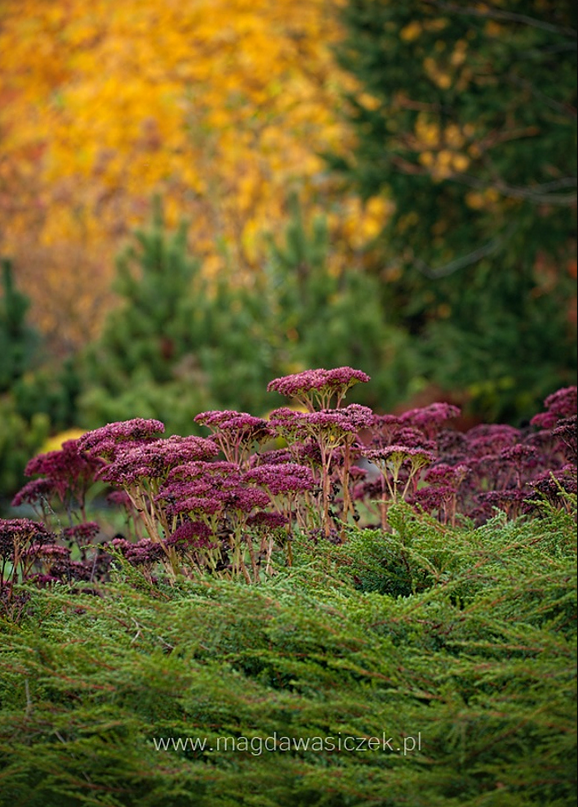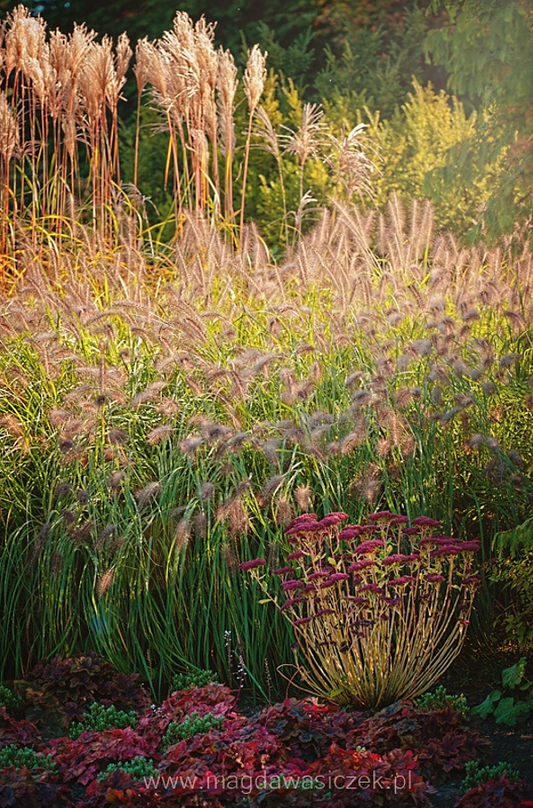El pasado otoño visitamos a unos amigos en Varsovia. Fue un estupendo viaje de cuatro días en el que estuve a punto de tener una metedura de pata de las que hacen época. A la hora de planificar el viaje, justo cuando nuestros amigos nos preguntaban qué nos apetecería conocer, me encontré en facebook con las fotos de un jardín que me resultó tan espectacular que a punto estuve de incluirlo en mi lista de los deseos. Se trataba del Arboretum Trojanow, situado en Opatówek, muy cerca de Kalisz, en la zona central de Polonia. Según Google Maps llegar hasta allí desde Varsovia es un trayecto de dos horas y media en coche. Con esa información, teniendo en cuenta que no disponíamos de mucho tiempo, que lo que nos apetecía era estar con nuestros amigos y que digamos que el resto del grupo no comparte una afición por los jardines que justifique cinco horas de coche con niños, fue fácil concluir que esta no era la ocasión. Gracias a dios me pudo la sensatez. A través de Marzena Bakowska, su propietaria, ahora he conocido que este jardín es privado y salvo en ocasiones muy contadas no está abierto al público. Sinceramente, si hubiésemos alquilado un coche y hubiese arrastrado a dos familias enteras a través de Polonia para ver un buen muro y una puerta cerrada, no creo que hubiese habido demasiada benevolencia hacia mi persona. Aunque tengo la firme convicción de que mi error hubiese sido comprensible. Toda la información que había encontrado estaba en Polaco, un idioma que parece igual de indescifrable para los latinos que para el traductor de Google. Pero sobre todo, ¿cómo va uno a imaginarse que semejante jardín sea un jardín privado? ¿cómo pensar que este jardín no deja de ser un hobby como lo es el mío? Veamos algunas cifras que sustentan lo que digo: el jardín tiene 17 años de antigüedad (lo que a mí me parece un suspiro vistos los resultados) y un tamaño de 8 hectáreas (lo que a mí me parece descomunal para un jardín privado). De acuerdo a su propietaria, el jardín cuenta con más de 3.000 variedades de vivaces, y más de 400 variedades de hierbas ornamentales. Solamente del género Miscanthus ya cuenta con cerca de 200 variedades. Y la colección de árboles y arbustos no hay más que mirar las fotografías publicadas en su web para ver que es de una enorme riqueza. Cuando las ves imaginas que un jardín así debe ser propiedad del estado o de alguna universidad. Ya no hay lores ingleses que se dediquen a la jardinería. La gente con nombre y apellidos no se dedica hoy en día a hacer un jardín de 8 hectáreas. O sí, y si no ahí está Marzena Bakowska, una abogada de profesión y jardinera de corazón para demostrarlo.
A veces tengo la sensación de que los diseñadores de jardines tienen dificultades para entrelazar en sus trabajos toda la riqueza vegetal que tienen a su alcance. Durante mucho tiempo pareció que los árboles y los arbustos tenían la exclusividad en los jardines. Y si se permitía la entrada de alguna herbácea esta sería sin duda una anual o césped. Movimientos como el Arts and Crafts y su arriate herbáceo en Inglaterra, y más recientemente la Nueva Ola de Perennes impulsada desde Holanda y Alemania han potenciado el uso de vivaces y gramíneas. Y cuando parecía que árboles, arbustos, vivaces, hierbas y anuales se disponían a convivir en los jardines, tengo el temor de que se estén invirtiendo las tornas y nos estemos olvidando de árboles y arbustos en los jardines de estilo naturalista. En ocasiones siento que el movimiento naturalista sólo estuviese interesado en la evocación de un tipo particular de ecosistema: la pradera o el prado. Hay diseñadores de jardines que demuestran que otras evocaciones son posibles con la combinación de árboles y arbustos junto a vivaces y hierbas, y el Arboretum Trojanow es muestra de ello. Precisamente lo que más me gusta de este jardín es la forma en que árboles, arbustos, vivaces y hierbas se combinan con gran elegancia. La integración entre hierbas y coníferas me resulta especialmente evocadora y es uno de mis puntos de referencia para la futura evolución de mi jardín. El estilo final del arboretum, creo que es de gran naturalismo sin llegar a emplear las herramientas de combinación y entremezclado de especies que promueven los movimientos modernos. En Trojanow se emplean grandes bloques alargados de una única especie de gramínea. Estas enormes extensiones de un un único tipo de hierba potencian las cualidades estructurales y de textura de cada especie, en un estilo que me recuerda a los jardines de James van Sweden y Wolfgang Oehme. Pero aquí el contraste en las yuxtaposiciones de los bloques de especies diferentes y los puntos de foco y contraste aportados por árboles y arbustos, especialmente los esbeltos abetos sobresaliendo sobre un mar de hierba, generan un jardín de enorme personalidad.
Arboretum Trojanow es un jardín con mucha suerte. Como todo gran jardín tiene la suerte de tener un gran jardinero, alguien que en un momento de su vida decidió dedicar una parte importante de su tiempo, su conocimiento y su pasión, de su vida en definitiva, a moldear y embellecer un pedazo de terreno. Pero en este caso, este jardín tiene además la suerte de haber sido retratado recientemente por dos de las más inspiradoras fotógrafas que conozco. Yo he elegido la obra de Magda Wasiczek (a la que agradezco enormemente su amabilidad por permitirme emplear sus fantásticas fotos en este blog) pero en la web también se pueden encontrar estupendas fotografías de Joahna Stoga y de la propia Marzena Bakowska. Yo me he atrevido a pedirle a Madga emplear sus fotografías porque tengo la convicción de que todos los que nos lanzamos a la creación de un jardín en mayor o menor medida lo hacemos persiguiendo el logro de un ideal estético, de refugio o de naturaleza, nuestra subconsciente idea de paraíso. Yo no sé definir cuál es mi idea de jardín soñado, pero creo que las fotos de Magda son capaces de agitar el rinconcito en el que esta idea se esconde.
After the photos you can see the english version.
Fuente: Magda Wasiczek, Arboretum Trojanow
We visited friends in Warsaw last fall. It was a great trip during which I was about to make an embarrassing mistake. When we were planning the trip, just when our friends asked us what would we like to visit, I found pictures of a garden so spectacular that I almost included it in my list of desires. It was the Arboretum Trojanow, located in Opatówek, near Kalisz, in central Poland. According to Google Maps it takes two hours to get there by car from Warsaw. With that information, taking into account that we did not have much time, that we wanted to be with our friends and that the rest of the group doesn't share my passion for gardens that justifies a five hour drive with children, it was easy to conclude that this was not the occasion. It was a good decision. Through Marzena Bąkowska, the owner, I have now found out that this garden is private and is not open to the public except on very rare occasions. Honestly, if we had rented a car and crossed Poland to see a good wall and a closed door, I don't think my family and friends would have been too kind to me. Despite the fact that I have the firm conviction that my mistake would have been understandable. All the information I had found was in Polish, a language that seems equally indecipherable to Latin people as for Google translator. But above all, how was I able to imagine that such a garden is a private garden? Here are some figures that support what I say: the garden is 17 years old (which seems to me a short period of time) and a size of 8 hectares (which seems to me huge for a private garden). According to its owner, the garden has more than 3,000 varieties of perennials, and more than 400 varieties of ornamental grasses. The garden has nearly 200 varieties of the genus Miscanthus. And you only have to look at the pictures published on its website to see the wealth of the collection of trees and shrubs. When you see the photos it's easy to imagine that such a garden should be owned by the State or a university. There are no English lords making gardens now. People with names and surnames don't pass their time making an eight-hectarea garden. Or maybe I'm wrong. We have Marzena Bąkowska, a lawyer by profession and amateur gardener, to prove that challenging gardening is still possible.
Sometimes it looks like garden designers can't use all the plant wealth they have at their fingertips. For a long time it seemed that exclusively trees and shrubs were used in gardens. And if a herbaceous plant was allowed, it would definitely be annual or moweb grass. Movements like the Arts and Crafts and herbaceous borders in England, and more recently the New Perennials Wave from Holland and Germany, have boosted the use of perennials and grasses. And when it looked as trees, shrubs, perennials, grasses and annuals were going to live together in the gardens, I have begun to fear that we are reversing the situation and we are forgetting trees and shrubs in the gardens of naturalistic style. Sometimes I feel the naturalist movement is only interested in the evocation of a particular type of ecosystem: the prairie or meadow. There are landscapers showing that other evocations are possible with the combination of trees and shrubs along with perennials and herbs, and Trojanow Arboretum reflects this. Precisely what I like most about this garden is the way in which trees, shrubs, perennials and herbs are combined with elegance. The integration between grasses and conifers is particularly evocative for me and is one of my references for future developments in my garden. The final style of the Arboretum Trojanow is of great naturalism without actually using the principles of combination and intermingling of species that promote modern movements. In Trojanow large stripes of a single species of grass are used. These huge blocks of a unique type of grass enhance the structural and textural qualities of each species in a style that reminds me of the gardens of James van Sweden and Wolfgang Oehme. But here the contrast between the juxtapositions of blocks of different species and the points of focus and contrast provided by trees and shrubs, especially those of the fir trees towering over a sea of grass, create a garden of huge personality.
Arboretum Trojanow is a lucky garden. Similarly to other gardens is fortunate to have a great gardener. In this case a woman who at one point in her life decided to devote a significant portion of her time, knowledge and passion, in other words a piece of her life, to shaping and beautifying a piece of land. But in this case, this garden is also lucky to have been recently portrayed by two of the most inspiring photographers I know. I have chosen the work of Magda Wasiczek (who I'm extremely grateful to for allowing me to use her fantastic photos on this blog) but on the web you can also find great pictures by Joahna Stoga and Marzena Bąkowska. I dared ask Magda if I could use her photographs because I have the conviction that all the people working in the creation of a garden in varying degrees are pursuing the achievement of an aesthetic, shelter or nature ideal, our subconscious idea of paradise. I don't know how to define what my dream garden is, but I'm sure that Magda's photos are able to shake the corner where this idea is hidden.



















